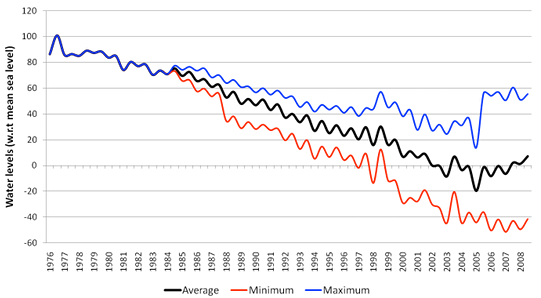Over the last several years, scientists have grown increasingly alarmed about the depletion of groundwater in many parts of India. However, even in a country with severe, widespread looming water shortages, the case of North Gujarat stands out.
For more than three decades now, the farmers of North Gujarat have been productively utilizing the rich groundwater resources of the region in order to cultivate a variety of crops and a thriving dairy industry. The state of Gujarat (along with the Government of India) has also played its role in supporting this enterprise by providing these farmers with a variety of subsidized inputs, including reliable electricity for pumping groundwater as well as marketing and price supports.
Unfortunately, because of the low levels of natural recharge of local aquifers, groundwater tables have fallen steadily throughout the same period. The groundwater situation is now so dire that the future of agriculture in North Gujarat is in jeopardy. Farmers are the first to suffer, as they must continually invest in deeper wells and more powerful pumps to irrigate, but nonetheless face a decline in both the quantity and quality of the water they are able to pump.
The effect of acute water shortages goes beyond immediate impacts on farmers. Under the current subsidy system, each year the government is forced to finance increasing amounts of expensive electricity for irrigation pumping, even as the benefit of pumping for farmers stagnates or declines as the amount of water available decreases. In addition, high consumption of electricity for irrigation puts pressure on the electrical grid and reduces available electricity for other sectors.
For the initial phase of its Gujarat project, the Columbia Water Center conducted an analysis of the water crisis in the Kukarwada sub-district in the Mehsana region. The study included a detailed survey of farmers and well operators in the region, along with an analysis of local hydrology, current energy policy and the potential for combining new incentive structures with water-saving technology to stabilize or reverse groundwater depletion in the region.
The study found that based on observation wells and farmer surveys, water tables in the study area have been falling steadily over the last 15-20 years, and have reached about 600ft below ground level, risking irreversible salinization of aquifers. The declining trend is seen in observation wells and confirmed by farmers’ own recollection of water depth. The rate of decline is anywhere between 9 to 20 feet per year.

To deal with falling water tables, farmers need to continuously drill deeper wells and buy more powerful pumps. However, although the horsepower usage and the depth of wells have increased dramatically over time, an average well can now irrigate only about 60% of its command area during the or winter-crop season. Nearly all respondents expected the water table to continue its decline, and on an average expect water to last for about six years. Once that happens, more than half of farmers in the area plan to abandon irrigated agriculture.
At the same time, energy use appears to have increased over the last two decades without a matching increase in irrigated area. In other words, the “drop per unit of energy consumed” continues to deteriorate, a situation that can is only made possible through large government subsidies. In fact, at depths from which groundwater is currently extracted, tubewell irrigated agriculture as practiced today is probably not financially viable.
Finally, while the study indicated that there were a number of practices and technologies that could increase water and energy use efficiency, they are, with few exceptions, not adopted by farmers in in the study area. The main reasons for this, farmers said, was high cost, land fragmentation and lack of familiarity.
The Challenge
Based on the results of this study, Columbia Water Center scientists began developing an approach to help farmers in the region save water. Given political and financial constraints, they determined that a successful approach would have to provide farmers both an incentive to apply water-saving approaches along with extension support to do so.
In partnership with the local electrical utility and the Gujarat government, the Center developed a pilot project that rewarded farmers by reducing the flat rate they paid for electricity for cutting water and energy consumption relative to a standard baseline based on historical use. As part of the project, farmers agreed to have their usage metered.
Goals of the incentive program included, making the farmer direct beneficiary of reduced water use, providing information and measurement tool and ensuring that the project was revenue neutral for the government.
The project then coupled the incentive scheme with mutifaceted support for water-saving approaches, including:
- Farmer level implementation of identified crop specific water-energy saving strategies (tensiometers, drip irrigation, furrow irrigation and mulching among others)
- Extensive farmer level agricultural extension activities to raise awareness and build capacities
- Farm level GIS maps prepared that capture the land holding size, cropping pattern, area.
- Crop diversification (less water intensive-high remunerative crops) introduced in partnership with FieldFresh (Bharti-Delmonte group)
- Electricity bill redesigned that captures water savings
- Energy meters installed for each borewell to measure savings; load rectification completed (electricity company)
To date over 800 farmers have been enrolled. June of 2012 will mark the completion of the first year of field implementation, at which point the project will have documented the relative efficacy of various interventions as well as capturing behavioral changes through a new energy bill design to refine the incentive approach and scale up for subsequent years.
Video: Achieving Sustainable Water, Energy and Agriculture in Gujarat, India
CWC White Paper: Addressing the Water Crisis in Gujarat, India
